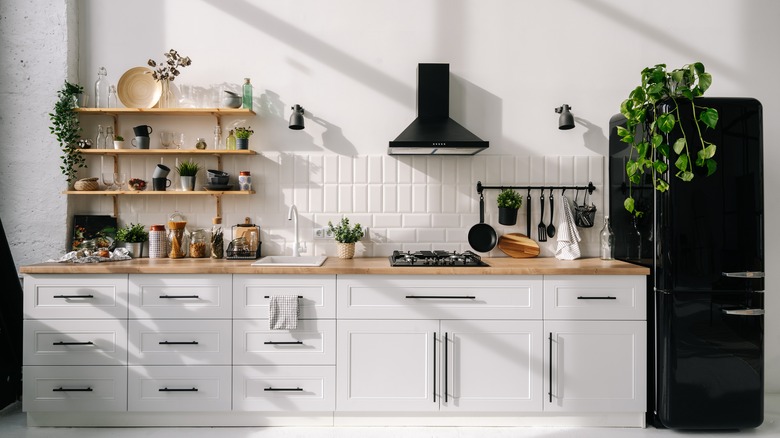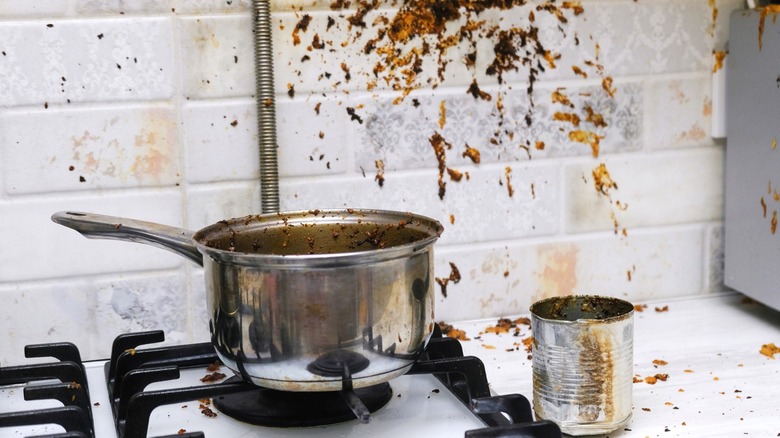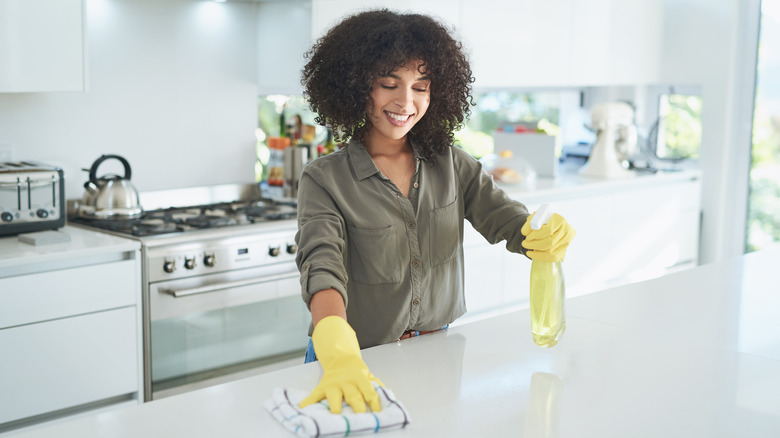How To Effortlessly Clean Cooking Oil Splatter Off Your Kitchen Walls
Cleaning up food splatter is one of the least glamorous aspects of cooking at home, but it has to be done. Unless, that is, you want to put a frame around those specks of grease and oil and claim it's a priceless Jackson Pollock painting. Of course, explaining why the frame is right next to the stove might make the story a bit hard to swallow — much harder to swallow, anyway, than all the wild and delicious food that caused the splatters.
Fortunately, cleaning up cooking oil splatter doesn't have to be difficult if you have the proper cleaning solution. It's important to note that the degreasers commonly used on stoves or countertops aren't recommended for walls. Wall surfaces, too, can vary — from wallpaper, for example, to certain types of paint finishes — and thus may require different solutions. But in most cases, a combination of white vinegar, mild soap, and water will work wonders on kitchen walls. Ideally, this mixture should be applied with a damp sponge to wipe the food-splattered area.
If the stains aren't all removed on the first attempt, you'll need to dry the area before wiping it down and rinsing again — and again, if necessary.
Steps for cleaning kitchen wall splatter
The goal is not only to achieve clean kitchen walls, of course, but also to ensure that the walls haven't been scratched or discolored because of your cleaning efforts. Therefore, the first step after preparing your cleaning solution should always be to perform a small spot test. This ensures that the solution doesn't damage your walls in any way. As for the cleaning solution itself, proper mixing is essential. The correct proportion of ingredients is three cups of water to one cup of white vinegar, with even less (half a cup) mild dish soap.
You will need two containers: one for your cleaning solution, and another with plain water for rinsing. Additionally, you should have two clean sponges at the ready; one for cleaning and the other for rinsing. Both sponges should be wrung-out and merely damp prior to use. Using the sponge designated for cleaning, gently wipe the walls first with the cleaning solution. Then, rinse the walls using the second sponge and plain water.
Once the rinse has been applied, the walls must be dried. Leaving kitchen windows open can expedite drying, but the use of a cloth towel is also recommended.
Things to avoid when cleaning kitchen wall splatter
Now that you know the correct steps for cleaning food splatter from kitchen walls, it should be noted that several potential missteps can occur if you're not careful. One such mistake is using a soaked sponge, which can result in water damage. Be sure to wring out the sponges thoroughly before applying them to the walls.
Using a cleaning solution with white vinegar is generally fine for your kitchen walls and cabinets, but caution must be exercised in some cases. For example, vinegar should never be used on certain kitchen furnishings and fixtures, due to the potential for damage or discoloration. These include any items made from stainless steel, cast iron, or unfinished wood.
Vinegar-aided cleaning solutions may also be too harsh for some paint finishes, such as eggshell and matte, which respond better to simple soap and water mixtures. Glossy, semi-glossy, and oil paints can typically handle cleaning solutions with vinegar, but the first two are susceptible to scratching. Thus, gentleness is recommended when wiping and rising.



